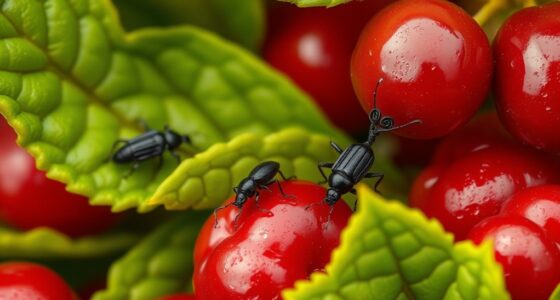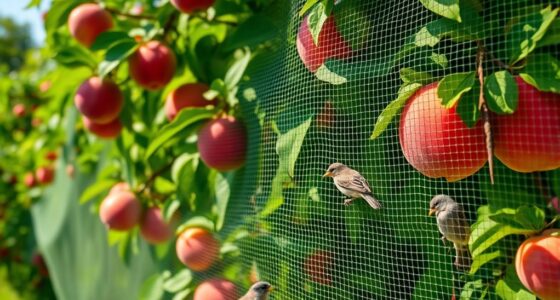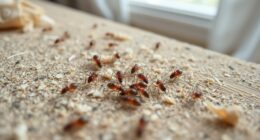To identify codling moth damage, look for small holes, frass, and internal worm tunnels in your apples, often after thinning. Monitoring begins early in the season with pheromone traps and inspecting trees for moths and eggs. Timing control measures during peak egg hatch—usually 8-14 days after egglaying—is essential. Proper sanitation and applications tailored to moth activity help minimize damage. Continue exploring strategies to keep your orchard healthy and pest-free.
Key Takeaways
- Look for small holes, frass, and internal worm damage on apples as signs of codling moth activity.
- Monitor moths using pheromone traps and inspect orchard trees regularly to determine peak activity periods.
- Time control measures, such as insecticide sprays, during egg hatch or larval entry stages for maximum effectiveness.
- Conduct orchard sanitation by removing fallen fruit and debris to reduce overwintering moth populations.
- Use integrated pest management combining biological controls, cultural practices, and appropriately timed chemical applications.
Recognizing the Signs of Codling Moth Damage on Apples

To effectively manage codling moth damage, you need to know how to recognize its signs on apples. Look for small holes or entry points on the fruit surface, often accompanied by frass (moth droppings) nearby. Early detection is key, so regularly inspect your orchard, especially after fruit thinning, when the fruit is more accessible. Orchard sanitation is essential; remove fallen or damaged apples to reduce breeding sites for the moths. Keep an eye out for affected fruit with internal worm damage, which might be visible when you cut into the apple. By maintaining good orchard hygiene and conducting frequent inspections, you can catch early signs of infestation and prevent widespread damage. Proper recognition allows for timely intervention and better pest management.
Understanding the Life Cycle of the Codling Moth

Have you ever wondered how the codling moth develops and causes damage to apples? Understanding its life cycle helps you better manage infestations. The cycle begins with moth mating, which occurs in spring or early summer, leading to egg laying on fruit. After a few days, eggs hatch, and larval emergence occurs. The tiny larvae burrow into the apple, feeding and causing damage. As they mature, they leave behind frass and tunnels. The larvae then pupate inside the fruit or in the orchard debris, ready to emerge as adult moths. Leverage in pest management strategies can improve timing and effectiveness. Key points include:
Understanding the codling moth’s life cycle aids in effective apple pest management.
- Moth mating triggers egg laying
- Eggs hatch within days
- Larval emergence causes initial damage
- Larvae tunnel inside apples
- Pupation occurs in protected sites
Knowing this cycle helps you time control measures effectively.
When to Monitor for Moth Activity During the Growing Season

You should start monitoring for moth activity early in the season, just as buds begin to open. The peak flight period usually occurs a few weeks later, when moths are most active and can cause the most damage. Tracking these key times helps you time your control measures effectively.
Early Season Moth Activity
Monitoring for codling moth activity should begin early in the growing season, ideally just as buds start to swell. Early moth activity is influenced by moth behavior and pollination timing, so early detection is key. During this period, moths become active and start laying eggs, making it the perfect time to monitor. Look for these indicators to identify early activity:
- Emergence of moths around tree trunks and branches
- Increased moth sightings during warm, sunny days
- Fresh egg deposits on fruit or leaves
- Presence of small, white eggs on bark or buds
- Signs of early larval entry in fruit
- Understanding the contrast ratio of your monitoring tools can improve detection accuracy during variable lighting conditions.
Monitoring early helps you time control measures precisely, reducing damage later in the season. Being vigilant now guarantees you stay ahead of the pest’s development cycle and protect your apple crop.
Peak Moth Flight Period
The peak moth flight period typically occurs during mid to late summer when adult moths are most active and widespread. During this time, you’ll want to monitor moth activity closely using moth pheromone traps. Place these traps at canopy height, ideally near the orchard’s center or along the perimeter, to intercept moths migrating into the orchard. Consistent trap monitoring helps identify the height and timing of peak flight, signaling when to implement control measures like insecticide applications or mating disruption. This period is critical for effective management because moths are actively reproducing, increasing the risk of damage. By tracking moth pheromone trap catches, you can better time your interventions, reducing codling moth populations and protecting your apple crop. Understanding pest behavior can further improve your integrated pest management strategies.
Effective Timing for Applying Control Measures

To effectively control codling moths, you need to monitor their development stages closely. Timing your control measures around egg hatch ensures treatments target the most vulnerable pests. Knowing the ideal spray windows helps maximize your efforts and reduce apple damage. Utilizing appropriate spray tips can further improve the precision and efficacy of your applications.
Monitoring Pest Development Stages
Understanding the pest development stages is crucial for timing control measures effectively. Accurate monitoring helps you determine when to act before infestations escalate. To do this, focus on:
- Regularly inspecting traps to track moth activity
- Placing traps strategically to avoid pest resistance
- Using multiple trap types to catch different stages
- Recording trap catches to identify peak activity periods
- Adjusting trap placement based on orchard layout for better detection
- Recognizing how pest life cycles influence optimal intervention timing, which can be informed by Juice Cleanse and Detox insights on nutrient-rich ingredients that support overall plant health.
Monitoring helps you recognize when moths are most active, enabling timely interventions. Proper trap placement reduces the risk of pest resistance, ensuring traps remain effective over time. Consistent observation allows you to stay ahead of pest development, making control measures more efficient. This targeted approach minimizes unnecessary treatments and maximizes your orchard’s health.
Timing of Egg Hatch
Monitoring pest development stages helps you anticipate when eggs are likely to hatch, so you can time your control measures effectively. Egg hatch typically occurs about 8-14 days after adult moths lay eggs. Using pheromone traps helps you detect adult activity, indicating when eggs are about to hatch. Automation technologies are increasingly being used in pest management to improve timing and application precision.
| Stage | Timing |
|---|---|
| Egg laying | When pheromone traps catch males |
| Egg hatch | 8-14 days after egg laying |
| Moth emergence | Followed by egg hatch |
Keep a close watch on pheromone trap catches, and plan to apply controls just before or during egg hatch to maximize effectiveness. Proper timing reduces damage and improves control success.
Optimal Spray Windows
Timing your spray applications to coincide with the critical spray window is essential for effective codling moth control. Applying treatments at the right time targets young larvae before they damage fruit. Key considerations include monitoring pest development and weather conditions. To maximize effectiveness, consider:
- Synchronizing sprays with egg hatch periods
- Using pest resistant varieties to reduce infestation pressure
- Maintaining orchard sanitation to remove fallen fruit and debris
- Watching for pheromone trap alerts to time sprays accurately
- Avoiding pesticide resistance by rotating active ingredients
- Incorporating essential oils known for their natural insect-repelling properties can provide an eco-friendly supplement to traditional control methods.
These strategies help ensure your sprays hit the moths when they’re most vulnerable. Proper timing minimizes chemical use and enhances control, especially when combined with orchard sanitation and resistant varieties. Staying vigilant during these windows reduces damage and promotes healthier yields.
Cultural Practices to Minimize Moth Infestation

Implementing effective cultural practices is essential for reducing codling moth infestations in apple orchards. One key practice is cover crop management, which helps improve soil health and promotes beneficial insects that can suppress moth populations. Proper cover crop selection and timing reduce habitat for overwintering moths. Additionally, orchard sanitation plays a *vital* role; removing fallen fruit, debris, and damaged fruit minimizes breeding sites for larvae and disrupts the moth’s life cycle. Regularly cleaning up orchard floor areas prevents moths from establishing and reduces early-season populations. Using vetted products and practices can enhance control efforts. Combining cover crop management with diligent sanitation creates an inhospitable environment for codling moths, decreasing the likelihood of infestations and supporting the effectiveness of other control measures.
Biological and Chemical Control Options

Biological and chemical control options are essential tools for managing codling moth populations effectively. Biological control involves natural predators like Trichogramma wasps or Bacillus thuringiensis, which target moth eggs and larvae. Chemical options include insecticides that can be timed precisely to disrupt moth development. To maximize effectiveness, consider these strategies:
- Apply biological agents early in the season for preventive control
- Use insecticides selectively to minimize resistance development
- Rotate chemical options to prevent moth tolerance
- Combine biological and chemical methods for integrated pest management
- Follow label instructions for proper application timing and dosage
- Monitoring market trends can help optimize control timing and strategies.
Monitoring and Assessing the Effectiveness of Your Strategies

To guarantee your codling moth management strategies are working effectively, you need to regularly monitor your orchard for signs of infestation and measure the impact of your control measures. Use pheromone traps to track moth activity and detect pest resistance early. Keep detailed records of trap catches, fruit damage, and timing of treatments to evaluate their effectiveness. Consider weather impact, as rain or temperature fluctuations can influence moth emergence and control success. Adjust your strategies if pest resistance appears or if weather conditions disrupt expected outcomes. Regular monitoring helps you identify problem areas promptly, ensuring you can fine-tune your approach and avoid unnecessary pesticide use. This proactive assessment keeps your orchard healthier and more productive, reducing damage over time. Incorporating vetted products designed for apple orchards can enhance your control efforts and improve overall results.
Frequently Asked Questions
How Does Weather Influence Codling Moth Emergence and Activity?
You should know that weather patterns greatly influence codling moth emergence and activity. Warm temperatures accelerate moth development, leading to earlier emergence, while cooler weather delays it. Humidity and rainfall also play roles; wet conditions can reduce moth activity and disrupt their lifecycle. Understanding these weather influences helps you time control measures effectively, ensuring you target the moths when they’re most vulnerable and minimize damage to your apples.
Are There Resistant Apple Varieties to Codling Moth Infestation?
Did you know some apple varieties are more resistant to codling moths? Resistant cultivars can reduce infestations markedly, making management easier. Breeding programs focus on developing these resistant varieties to help growers and backyard gardeners alike. While no apple is completely immune, choosing resistant cultivars can lower pesticide use and increase fruit quality, offering a sustainable, eco-friendly approach to controlling codling moths.
What Are the Economic Thresholds for Treatment Decisions?
When considering economic thresholds for treatment decisions, you should monitor pest levels carefully. Typically, if you find about 5% infested fruit or more than one larva per trap, it’s time to treat. These thresholds help you avoid unnecessary pesticide use while protecting your crop’s profitability. By staying vigilant and applying treatments only when thresholds are exceeded, you can effectively manage codling moths and maximize your orchard’s economic return.
Can Organic Methods Effectively Control Codling Moth Damage?
You can effectively control codling moth damage using organic methods by leveraging natural predators and applying organic sprays. Natural predators like Trichogramma wasps help reduce moth populations naturally, while organic sprays such as neem oil or spinosad provide targeted control without harsh chemicals. Combining these approaches regularly during key development stages strengthens your defense, making organic methods a viable, eco-friendly solution for managing codling moths in your apple orchard.
How Does Crop Rotation Impact Codling Moth Populations?
Think of crop rotation as a shield that disrupts codling moth life cycles. By rotating apples with cover crops, you boost soil health and introduce benefits like improved nutrient cycling. This practice also prevents moth populations from settling in, much like a rotating door keeps pests moving along. Ultimately, crop rotation helps break the cycle, reducing infestations naturally and supporting healthier trees and ecosystems.
Conclusion
By staying vigilant and timing your control measures precisely, you can guard your orchard like a sentinel watching over ripening fruit. Picture the delicate dance of moths and apples, where early detection and thoughtful intervention act as your shield against silent damage. With each careful step, you nurture vibrant, unblemished apples, turning your orchard into a sanctuary of health and abundance. Your attentive efforts transform a fragile fruit into a bountiful harvest, ripe and resilient against unseen threats.









